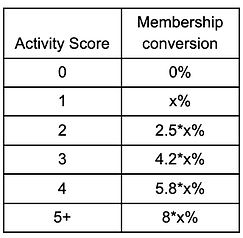🎯 Case Study: Rethinking the 14-Day Trial Funnel
At my previous company, we offered a 14-day unlimited class trial. We had a reliable Activity Score metric to quantify user engagement — the higher the score, the more likely someone was to convert to a paid membership.
To illustrate, the typical trend usually looks something like this:

For two years, this trend held steady. Everyone was comfortable with it.
"This is just how it works."
But I started to question that assumption.
What if the trial structure itself was holding us back?
🔍 The Hypothesis
Since convincing people to exercise is already tough, I wondered:
Does timing within the trial impact conversion likelihood?
Hypothesis:
Users who attend classes earlier in the trial might behave differently than those who wait until later.
📊 The Study
To test this, I analyzed the last day a user attended a class and matched it with their Activity Score.
-
If a user had an Activity Score of 4 and last attended class on Day 14, they had a ‘d’% chance of converting.
-
If their last class was on Day 7, the chance dropped to 0.6d
This pattern held across all Activity Scores.

🧠 Insight
Even when users had the same number of classes, those who attended later in the trial converted at a 35% higher rate on average.
The longer the trial, the more likely users are to fall into inertia.
Early momentum fades. Pizza wins.
🚀 The Execution
With this insight, I proposed a switch to a 7-day trial.
Result:
✅ 34% boost in membership conversions.
🏁 The entire platform adopted the 7-day model shortly after.
🧠 The Lesson
Sometimes, growth is in plain sight.
All you need is the courage to question the assumptions that feel like absolute truth.